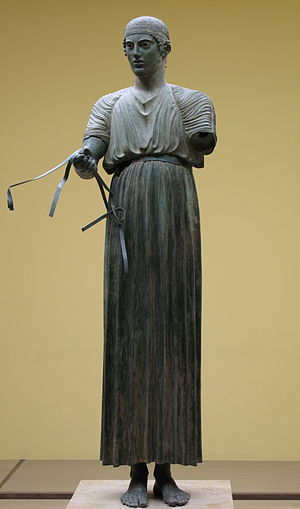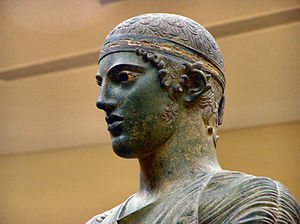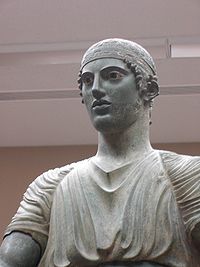- Charioteer of Delphi
-
"Charioteer" redirects here. For the British tank, see Charioteer tank destroyer.This article is about the statue. For the children's novel by Caroline Lawrence, see The Charioteer of Delphi.
The Charioteer of Delphi, also known as Heniokhos (the rein-holder), is one of the best-known statues surviving from Ancient Greece, and is considered one of the finest examples of ancient bronze statues. The life-size statue of a chariot driver was found in 1896 at the Sanctuary of Apollo in Delphi. It is now in the Delphi Archaeological Museum.
The statue was erected at Delphi in 474 BC, to commemorate the victory of a chariot team in the Pythian Games, which were held at Delphi every four years in honor of Pythean Apollo. It was originally part of a larger group of statuary, including the chariot, four (possibly six) horses and two grooms. Some fragments of the horses were found with the statue. When intact, it must have been one of the most imposing works of statuary in the world.
An inscription on the limestone base of the statue shows that it was commissioned by Polyzalus, the tyrant of Gela, a Greek colony in Sicily, as a tribute to Apollo for helping him win the chariot race. The inscription reads: [P]OLUZALOS MA nETHÊK[EN] ...]ON AES EUONUM APOLL[ON], which is reconstructed to read "Polyzalos dedicated me. ... Make him prosper, honoured Apollo."
The Sicilian cities were very wealthy compared with most of the cities of mainland Greece and their rulers could afford the most magnificent offerings to the gods, also the best horses and drivers. It is unlikely, however, the statue itself comes from Sicily. The name of the sculptor is unknown, but for stylistic reasons it is believed that the statue was cast in Athens. It has certain similarities of detail to the statue known as the Piraeus Apollo, which is known to be of Athenian origin.
The Charioteer himself is intact except that his left arm is missing. Greek bronzes were cast in sections and then assembled. When discovered, the statue was in three pieces—head and upper torso, lower torso, and right arm. The left arm was probably detached and lost before the statue was buried. This was probably done to protect it from looters, some time after the Sanctuary at Delphi was closed in the 4th century AD.
The statue is one of the few Greek bronzes to preserve the inlaid glass eyes and the copper detailing of the eyelashes and lips. The headband is of silver and may have been inlaid with precious stones, which have been removed.
The figure is of a very young man, as is shown by his soft side-curls. Like modern jockeys, chariot racers were chosen for their lightness, but also needed to be tall, so they were frequently teenagers. He is wearing a xystis, the garment which drivers wore while racing. It falls to his ankles and is fastened high at the waist with a plain belt. The two straps that cross high at his upper back prevented the xystis from "ballooning" during the race.
Stylistically, the Charioteer is classed as "Early Classical" or "Severe" (see Greek art). The statue is more naturalistic than the kouroi of the Archaic period, but the pose is still very rigid when compared with later works of the Classical period. One departure from the Archaic style is that the head is inclined slightly to one side. The naturalistic rendering of his feet was greatly admired in ancient times. This sculpture displays several advancements on Archaic sculpting style - the introverted expression does away with the old 'Archaic smile' and he would not have been clothed in the Archaic period. His robes are a testament to the talent of the sculptor. There would have been a chariot to cover most of the waist and below, so not much interested is added to his robes, however.
More pictures at Wikimedia Commons. [1]
External links
- Charioteer of Delphi. Ancient Greece.
- Charioteer of Delphi. University of Saskatchewan.
- Delphi: The Bellybutton of the Ancient World. Michael Scott. BBC 4. 21:42 minutes in. Retrieved on 23 Nov 2010.
Categories:- 5th-century BC Greek sculptures
- Ancient chariot racing
- Carriage drivers
- Delphi
- Ancient Greek athletic art
Wikimedia Foundation. 2010.




